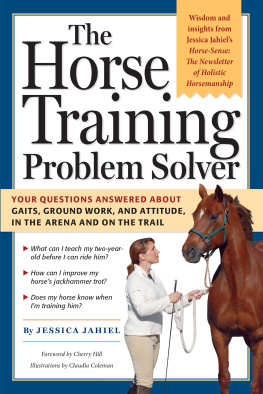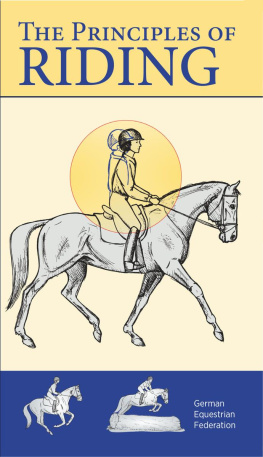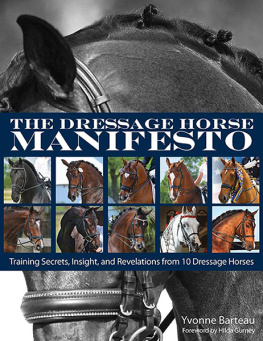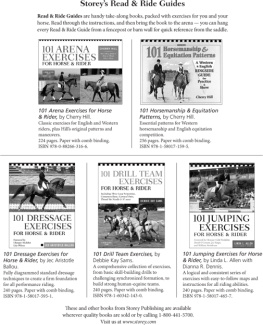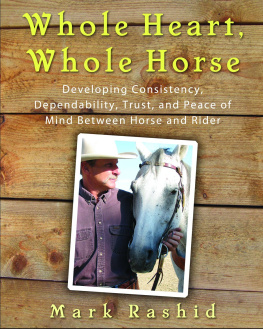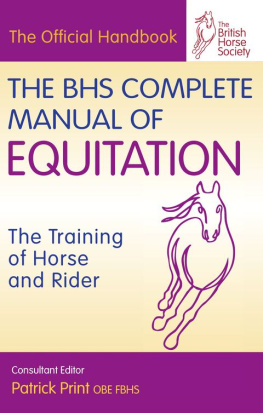Contents
Dedication
To three dear friends, now deceased, who understood horses and humans and did a superb job of educating both: Sally Graburn, Jill Hassler, and Dr. Reiner Klimke.
And as always, to my parents, who were born to teach and have always done it so very, very well.
Acknowledgments
No book is ever the creation of a single individual. In the case of this book, several people (and one particular group of people) stand out for their special contributions:
Madelyn Larsen, agent and friend, who found the ideal publisher for this series of books.
Deb Burns, Lisa Hiley, and Ilona Sherratt, the Storey dream team that gave the book its form.
Claudia Coleman, the extraordinary artist whose illustrations have once again made horses come alive on the pages of a book.
Karen Fletcher, Web Goddess, without whom the Horse-Sense mailing list and Web site would never have become a reality.
Last but not least: the Horse-Sense readers who have been asking questions and telling their stories for more than 10 years. They are all constantly struggling with the difficulty of matching theory to practice and applying horse management concepts and general training principles to the individual animals that they love, care for, and try so hard to understand. Without them, this book would not exist.
Foreword
Jessica Jahiels writing is intelligent and thoughtful, generous and measured, sound and systematic, clever and entertaining, clear and consistent, honest yet tactful, helpful and encouraging. Jessica is an educated, respected, experienced, and qualified instructor and teacher, who is joyfully optimistic about horses and their people yet realistic and practical with her advice. Her horse training approach is the classic time-honored, thorough method. She is more interested that her readers and their horses have a safe, positive experience than quick results.
As she answers many specific common questions, Jessica explains the difference between being considerate of your horse and spoiling him, between discipline and abuse. She describes how much is too much, and when to look for another way. She provides excellent detailed information about tack and techniques but she shows us that the best solution to a problem usually comes from a combination of looking at ourselves and seeing things from the horses perspective.
She is a mirror of her horse training advice: Be clear, consistent and kind.
As you read this book, youll see that Jessica thoroughly enjoys horses, helping people, and writing. She makes us all feel that we and our horses are gold worthy of all of the effort and time it takes to do our very best.
Cherry Hill
Trainer, instructor, and author of 30 books and videos on horse training and care
Preface
The challenges and joys involved in horse training are similar whether that training takes place in Boston or Botswana. The same issues affect horses and their trainers no matter where they live and what riding discipline they follow. Because the cost of a healthy, sound, fully trained horse is often prohibitive, many riders find themselves training their horses because they have acquired young horses, rescue or rehabilitation projects, or ex-racehorses that they intend to retrain for new careers. Because fewer riders are brought up in a horse-rich environment, many of the riders who find themselves training horses are doing so for the first time. They have never had the opportunity to watch the full process of horse training, much less the opportunity to become the apprentice of an expert in horse training.
Since the inception of the Horse-Sense newsletter more than 10 years ago, horse owners and riders around the world have sent hundreds of questions about horse training, how horses learn, how horses should be taught, and how their owners and riders can learn to teach them. As with the previous books in this series, The Horse Behavior Problem Solver and The Riders Problem Solver, the people who ask these questions come from different backgrounds and different countries, follow different riding disciplines, own and ride different breeds of horses; and have different dreams and goals. And as with earlier books, all of the people who ask questions have three things in common. They share a passion for horses; they have open, questioning minds; and they wish very much to do right by the horses in their lives.
There are hundreds of books available on the subject of horse training. Many of these books are very helpful. But as so many readers have said over and over again, its one thing to understand the basic principles of training, but quite another to achieve the practical, personal application of those principles. What they want and need is personal help: specific advice that applies to their situations and their horses.
Every question in this book came from a person who wanted help with an individual horse in a specific situation. By bringing together this collection of questions from riders and horse owners all over the world, and answering each one in its own specific context, I hope I can help readers analyze their own situations and find solutions to some of the problems they may encounter.
The aim of this book is to help people analyze their horse training in terms of both the big picture (philosophy, principles, and practices of good horse training) and the all-important smaller details that are sometimes overlooked. I would like readers to be able to take the solid fundamentals recommended in so many horse books and use the information in this book to help them apply those good fundamentals to their own horses.
Every interaction is training in the sense that every interaction teaches the horse something about the person who is handling or riding it. But education is a two-way street. If we pay attention, every single interaction we have with our horses will teach us something, too. Horsemen around the world share certain qualities: a willingness to listen to their horses, a willingness to look at the world around them and ask questions, and above all, a willingness to give their horses the benefit of the doubt at all times.
Thats not all they share. When questions are about riding, nine no, make that ten out of ten situations are likely to require the rider to pay closer attention to her position and aids. When questions are about training, the common theme is once again the importance of the basics, in this case, the riders ability to observe her horse accurately, handle him kindly, and start at the beginning to develop the horses minds and emotions that is, his understanding and trust along with his body. True training must address all aspects of the horse.
If theres a single take-home message in these pages, it is this: Listen, read, watch, learn, but dont just memorize lists and memorize the right answers. Think about what you learn, discuss it with your friends, relate it to your past experiences, apply it to your daily interactions with your horse make it part of you. Keep your interest and your curiosity, and take joy in discovery.
My goal is to help you figure things out for yourself and to help you understand your horse so that you can teach him, train him, educate him in a way that will let him figure things out for himself, too. Most problems between humans and horses are the result of human actions sometimes those of a human involved in the current situation, sometimes those of a human who was involved with the horse in the past. Either way, the person who is in a position to figure out and fix whatevers wrong is the current human in the horses life

